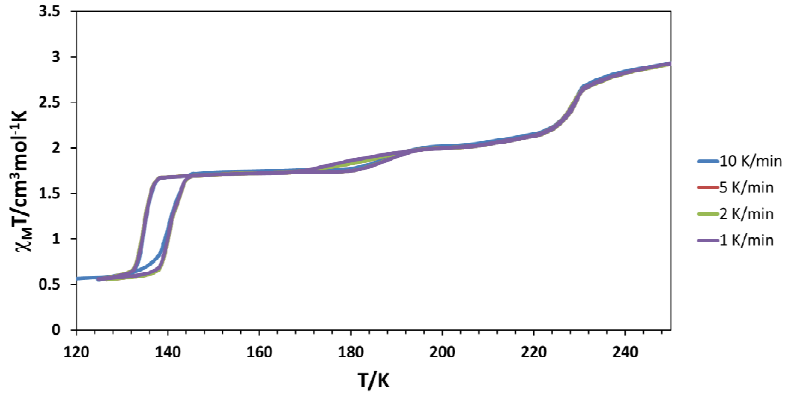From early on, we are taught to look at linear mathematical relationships as dependent variables that are determined by the value of an independent variable.
The reason that I find the phenomenon of hysteresis fascinating is that it is the violation of the above concept. By definition, the value of a dependent variable showing hysteresis depends not only on the value of the independent variable but also on whether the independent variable has been increasing or decreasing before it arrives at the value at which a measurement is taken. The dependent variable has a ‘memory’ of its path.
Examples of hysteresis are rare on a molecular level. One of several fascinating aspects of the recent Dalton Transactions paper by Guy Jameson and colleagues is that the (temperature-dependent) magnetism exhibited by the authors’ Fe(III) spin-crossover (SCO) complex shows two hysteresis loops; an example from Jameson and colleagues is shown below.

In transition metal complexes where both high spin and low spin states are possible, SCO occurs when a complex switches from one spin state to the other. Unsurprisingly, this is temperature-dependent, hence the temperature dependence of the magnetism. Hysteresis in magnetic measurements of SCO compounds is known, but Jameson and colleagues report a number of rare properties for the Fe(III) compound that they investigate, [Fe(qsal-Br)2]NO3•2MeOH (where qsal-Br denotes the (N-8-quinolyl)-5-bromo-salicylaldimate ligand).
The vast majority of complexes in which SCO occurs exhibit the phenomenon in a single step — at a certain temperature, all of the molecules in a bulk sample will convert from one spin state to the other. This is only the fifth example of a mononuclear Fe(III) complex that shows full SCO that occurs in two or more discrete increments where symmetry is lost within the molecular structure. In the case of this Fe(III) complex, the temperature range over which some metal nuclei are high spin, and some are low spin (in this case 50% each), is the largest ever reported for a mixed spin-state Fe(III): that is, 96 K.
Here, both steps exhibit hysteresis. The spin-state transitions occur at different temperatures when the authors start with the complex at 300 K and cool it, versus when they warm the complex from 4 K.
Read the full article at:
Abrupt two-step and symmetry breaking spin crossover in an iron(III) complex: an exceptionally wide [LS–HS] plateau
David J. Harding, Wasinee Phonsri, Phimphaka Harding, Keith S. Murray, Boujemaa Moubaraki and Guy N. L. Jameson
Dalton Trans., 2015, DOI: 10.1039/C4DT03184A
 |
Ian Mallov is currently a Ph.D. student in Professor Doug Stephan’s group at the University of Toronto. His research is focused on synthesizing new Lewis-acidic compounds active in Frustrated Lewis Pair chemistry. He grew up in Truro, Nova Scotia and graduated from Dalhousie University and the University of Ottawa, and worked in chemical analysis in industry for three years before returning to grad school. |










